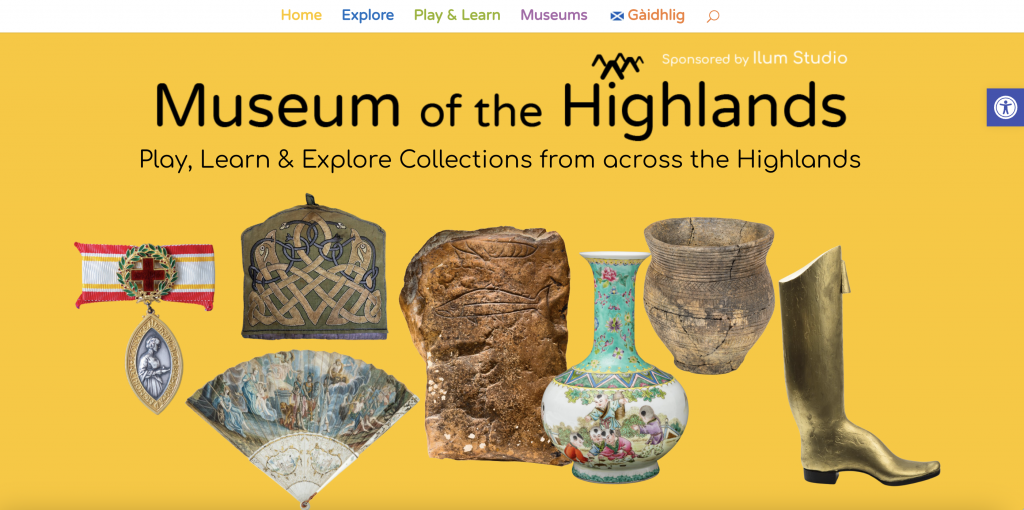
Museum of the Highlands is a new website offering novel and exciting ways to delve into the rich history of the Scottish Highlands. From archaeology and ancient stones to paintings, crofting tools, and complex colonial histories, incredible stories of the historic Highlands and its people are ready to be discovered.
The dynamic learning hub centres around an interactive timeline, allowing users to discover over 350 fascinating objects from 3 billion BC to present day. High-quality photographs along with detailed descriptions provide up close analysis of each object. Available to anyone interested in the history of the Scottish Highlands, 200 free resources, from fun games to in-depth learning aids, invite a deeper dig into the past. A Gaelic version of the website will be complete in the Autumn.


Fifteen diverse museums from across the Highlands collaborated to create the website, with project management by the heritage network organisation Museums and Heritage Highland. The project has been supported by Art Fund through its Reimagine programme and Museums Galleries Scotland.
Innovation and Network Manager at Museums Heritage Highland, Nicola Henderson, said:
“When the country went into lockdown in 2020, museums across the Highlands, like museums everywhere, looked for new ways to engage with people. Collectively, our network of museums developed the idea of an online digital learning hub sharing collections from across the Highlands. Thanks to funding from Art Fund and Museums Galleries Scotland, this spark of an idea has become Museum of the Highlands.
“We have created an engaging, fun and, most importantly, user-friendly website that supports individuals, families, schools and museums to engage meaningfully with museum collections at home or in the classroom.”
Museum of the Highlands learning resources have been developed in partnership with teachers and young people to support teachers to engage students and help them learn in innovative and creative ways, not just in history lessons. Object-based learning enhances engagement with many topics to suit our 21st-century Scottish curriculum.
Rosie Barrett, Digital Learning and Interpretation Specialist who worked on the project, said:
“For anyone new to object-based learning, the concept is simple. The term refers to using physical objects as a teaching aid. We can see, touch, and even smell things our ancestors held and used to learn about the past. This project challenged us to capture and convey these physical attributes for a digital platform.
“My work is focused on exploring objects in ways that help us to grow and develop, including cognitively. I am interested in the untapped potential of using historical artefacts in cross-curricular ways and supporting the whole learner and how we think. Objects from the past can help us make sense of the present and work towards the future. Throughout the project, we share objects in ways that stimulate curiosity and develop thinking.
“One learning resources is the set of debating activities. We consulted schools to find out what issues young people were interested in, then built the activities around objects from the fifteen museum collections. We have scaffolded discussions around questions of importance today. For example, a prehistoric harpoon features in a debate on animal rights, as we ask, ‘Should animals have rights like humans?’. This debate builds on students learning about their human rights and the democratic processes in Scotland. It also widens the topic to contemporary issues like choosing vegan and vegetarian lifestyles.”
An additional feature of the website encourages users to contact museums directly to find out more about their collections. Schools and other groups can also arrange virtually or in person visits.
While researching objects selected for the project, Museums discovered links to colonial history and the Transatlantic slave trade that they had not previously considered and uncovered complex colonial histories.
Freya Samuel, Digital Learning and Interpretation Specialist who also worked on the project, explains:
“Links to slavery and colonialism are prevalent in museums across the UK – the Highlands are no exception. Throughout the eighteenth and nineteenth centuries, it was common for wealthy Highlanders to be involved in colonial trade. The expansion of the British empire opened up new opportunities for pioneering Highlanders to make their fortunes, from military postings in the colonies, working for East India or Hudson Bay Companies, to livelihoods made as merchants or overseers profiting from the slave trade. These often-lucrative opportunities were particularly appealing to those facing hardship following the Highland clearances.
“It is important that we engage openly with this aspect of Highland history. We encouraged museums to think critically about their collections. Uncovering these links is not intended to villainize individuals or judge the ethics of the past by todays standards. It acknowledges these histories by including the voices and stories of the people exploited by the British Empire.”
Colonial themes presented through the website include the transatlantic slave trade, colonial collecting from Africa, Asia, North America, and Oceania, the Opium trade, colonial and post-colonial military battles, loot and the work of missionaries. Interpretation across the digital learning hub aims to take an informative yet balanced approach.
Museum of the Highlands is online now and free to access. It is supported by the Art Fund and Museums Galleries Scotland and is sponsored by Ilum Studio to help it grow and thrive post-launch.
Museum of the Highlands can be found at https://museumofthehighlands.org
